Microeconomic Analysis of Grain Price Volatility and Market Dynamics
VerifiedAdded on 2020/04/01
|17
|2975
|196
Report
AI Summary
This report provides a microeconomic analysis of grain price volatility, focusing on the Australian market and its connection to global trends. It examines the interplay of supply and demand, illustrating how factors like weather conditions and international demand influence wheat and barley prices. The report uses graphical representations to demonstrate shifts in supply and demand curves, explaining how excess supply in the domestic market led to low prices, while increased international demand caused prices to recover. Furthermore, it delves into the concept of elasticity of demand, highlighting its role in pricing decisions and market competitiveness. The analysis concludes by discussing the challenges faced by grain growers, emphasizing the impact of weather and market dynamics on price stability and future prospects.
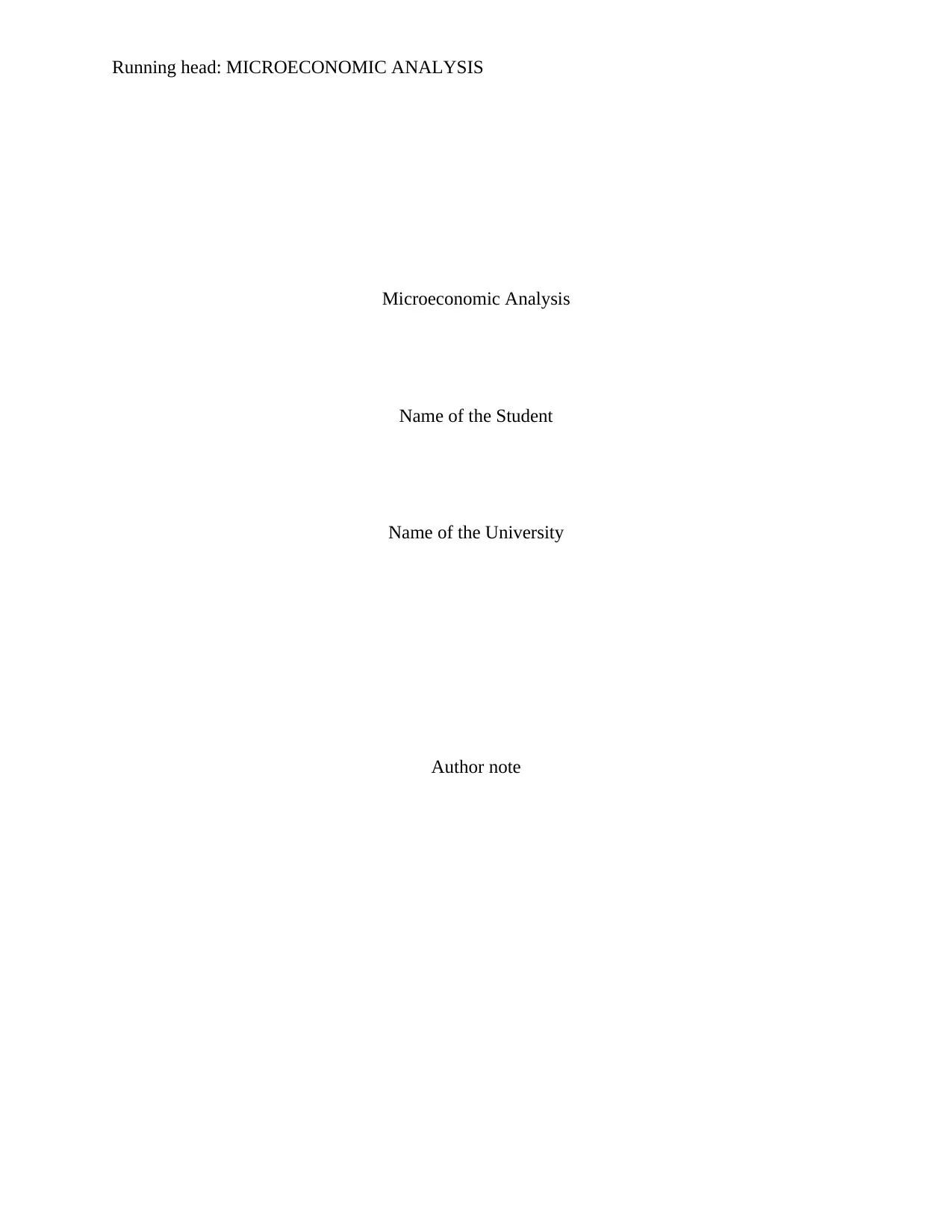
Running head: MICROECONOMIC ANALYSIS
Microeconomic Analysis
Name of the Student
Name of the University
Author note
Microeconomic Analysis
Name of the Student
Name of the University
Author note
Paraphrase This Document
Need a fresh take? Get an instant paraphrase of this document with our AI Paraphraser
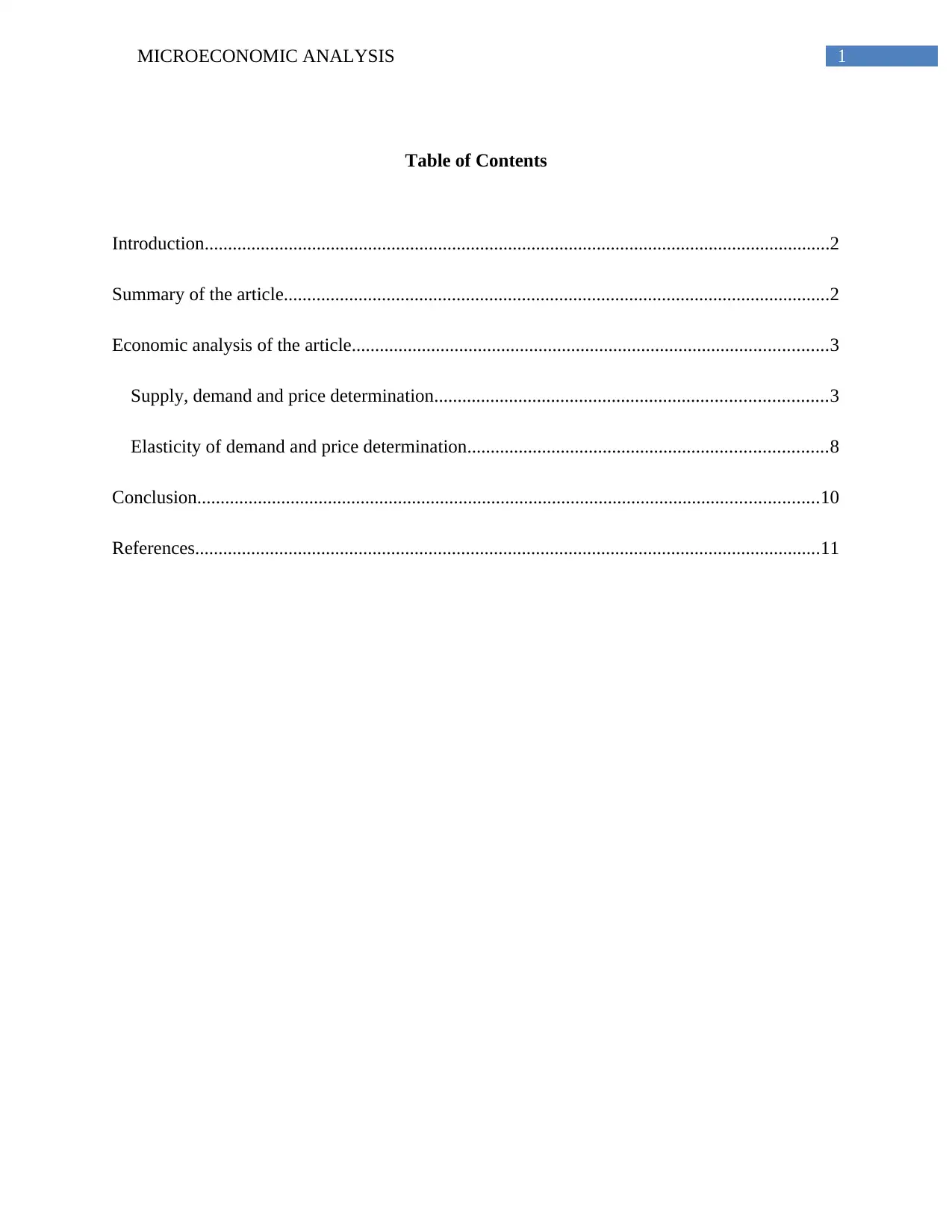
1MICROECONOMIC ANALYSIS
Table of Contents
Introduction......................................................................................................................................2
Summary of the article.....................................................................................................................2
Economic analysis of the article......................................................................................................3
Supply, demand and price determination....................................................................................3
Elasticity of demand and price determination.............................................................................8
Conclusion.....................................................................................................................................10
References......................................................................................................................................11
Table of Contents
Introduction......................................................................................................................................2
Summary of the article.....................................................................................................................2
Economic analysis of the article......................................................................................................3
Supply, demand and price determination....................................................................................3
Elasticity of demand and price determination.............................................................................8
Conclusion.....................................................................................................................................10
References......................................................................................................................................11
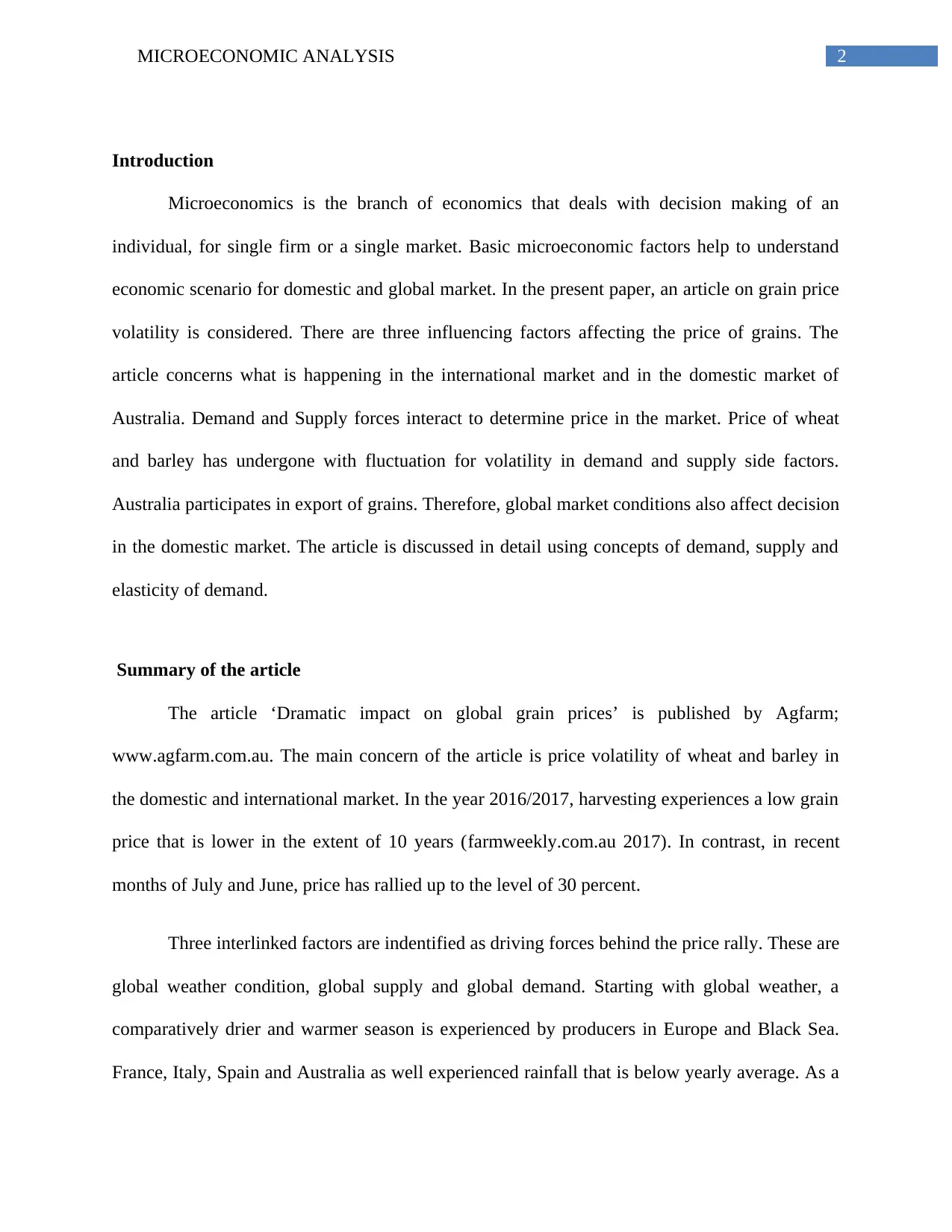
2MICROECONOMIC ANALYSIS
Introduction
Microeconomics is the branch of economics that deals with decision making of an
individual, for single firm or a single market. Basic microeconomic factors help to understand
economic scenario for domestic and global market. In the present paper, an article on grain price
volatility is considered. There are three influencing factors affecting the price of grains. The
article concerns what is happening in the international market and in the domestic market of
Australia. Demand and Supply forces interact to determine price in the market. Price of wheat
and barley has undergone with fluctuation for volatility in demand and supply side factors.
Australia participates in export of grains. Therefore, global market conditions also affect decision
in the domestic market. The article is discussed in detail using concepts of demand, supply and
elasticity of demand.
Summary of the article
The article ‘Dramatic impact on global grain prices’ is published by Agfarm;
www.agfarm.com.au. The main concern of the article is price volatility of wheat and barley in
the domestic and international market. In the year 2016/2017, harvesting experiences a low grain
price that is lower in the extent of 10 years (farmweekly.com.au 2017). In contrast, in recent
months of July and June, price has rallied up to the level of 30 percent.
Three interlinked factors are indentified as driving forces behind the price rally. These are
global weather condition, global supply and global demand. Starting with global weather, a
comparatively drier and warmer season is experienced by producers in Europe and Black Sea.
France, Italy, Spain and Australia as well experienced rainfall that is below yearly average. As a
Introduction
Microeconomics is the branch of economics that deals with decision making of an
individual, for single firm or a single market. Basic microeconomic factors help to understand
economic scenario for domestic and global market. In the present paper, an article on grain price
volatility is considered. There are three influencing factors affecting the price of grains. The
article concerns what is happening in the international market and in the domestic market of
Australia. Demand and Supply forces interact to determine price in the market. Price of wheat
and barley has undergone with fluctuation for volatility in demand and supply side factors.
Australia participates in export of grains. Therefore, global market conditions also affect decision
in the domestic market. The article is discussed in detail using concepts of demand, supply and
elasticity of demand.
Summary of the article
The article ‘Dramatic impact on global grain prices’ is published by Agfarm;
www.agfarm.com.au. The main concern of the article is price volatility of wheat and barley in
the domestic and international market. In the year 2016/2017, harvesting experiences a low grain
price that is lower in the extent of 10 years (farmweekly.com.au 2017). In contrast, in recent
months of July and June, price has rallied up to the level of 30 percent.
Three interlinked factors are indentified as driving forces behind the price rally. These are
global weather condition, global supply and global demand. Starting with global weather, a
comparatively drier and warmer season is experienced by producers in Europe and Black Sea.
France, Italy, Spain and Australia as well experienced rainfall that is below yearly average. As a
⊘ This is a preview!⊘
Do you want full access?
Subscribe today to unlock all pages.

Trusted by 1+ million students worldwide
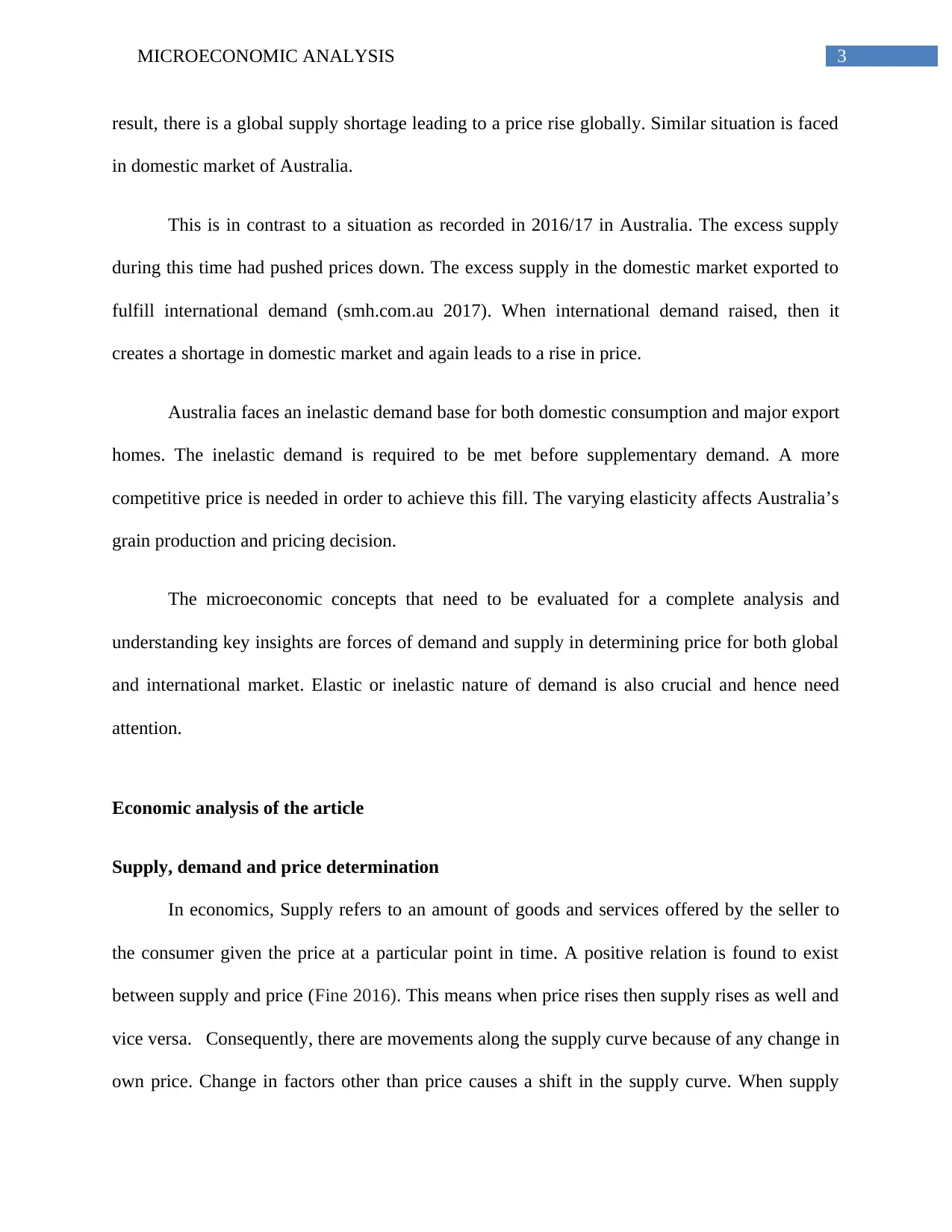
3MICROECONOMIC ANALYSIS
result, there is a global supply shortage leading to a price rise globally. Similar situation is faced
in domestic market of Australia.
This is in contrast to a situation as recorded in 2016/17 in Australia. The excess supply
during this time had pushed prices down. The excess supply in the domestic market exported to
fulfill international demand (smh.com.au 2017). When international demand raised, then it
creates a shortage in domestic market and again leads to a rise in price.
Australia faces an inelastic demand base for both domestic consumption and major export
homes. The inelastic demand is required to be met before supplementary demand. A more
competitive price is needed in order to achieve this fill. The varying elasticity affects Australia’s
grain production and pricing decision.
The microeconomic concepts that need to be evaluated for a complete analysis and
understanding key insights are forces of demand and supply in determining price for both global
and international market. Elastic or inelastic nature of demand is also crucial and hence need
attention.
Economic analysis of the article
Supply, demand and price determination
In economics, Supply refers to an amount of goods and services offered by the seller to
the consumer given the price at a particular point in time. A positive relation is found to exist
between supply and price (Fine 2016). This means when price rises then supply rises as well and
vice versa. Consequently, there are movements along the supply curve because of any change in
own price. Change in factors other than price causes a shift in the supply curve. When supply
result, there is a global supply shortage leading to a price rise globally. Similar situation is faced
in domestic market of Australia.
This is in contrast to a situation as recorded in 2016/17 in Australia. The excess supply
during this time had pushed prices down. The excess supply in the domestic market exported to
fulfill international demand (smh.com.au 2017). When international demand raised, then it
creates a shortage in domestic market and again leads to a rise in price.
Australia faces an inelastic demand base for both domestic consumption and major export
homes. The inelastic demand is required to be met before supplementary demand. A more
competitive price is needed in order to achieve this fill. The varying elasticity affects Australia’s
grain production and pricing decision.
The microeconomic concepts that need to be evaluated for a complete analysis and
understanding key insights are forces of demand and supply in determining price for both global
and international market. Elastic or inelastic nature of demand is also crucial and hence need
attention.
Economic analysis of the article
Supply, demand and price determination
In economics, Supply refers to an amount of goods and services offered by the seller to
the consumer given the price at a particular point in time. A positive relation is found to exist
between supply and price (Fine 2016). This means when price rises then supply rises as well and
vice versa. Consequently, there are movements along the supply curve because of any change in
own price. Change in factors other than price causes a shift in the supply curve. When supply
Paraphrase This Document
Need a fresh take? Get an instant paraphrase of this document with our AI Paraphraser
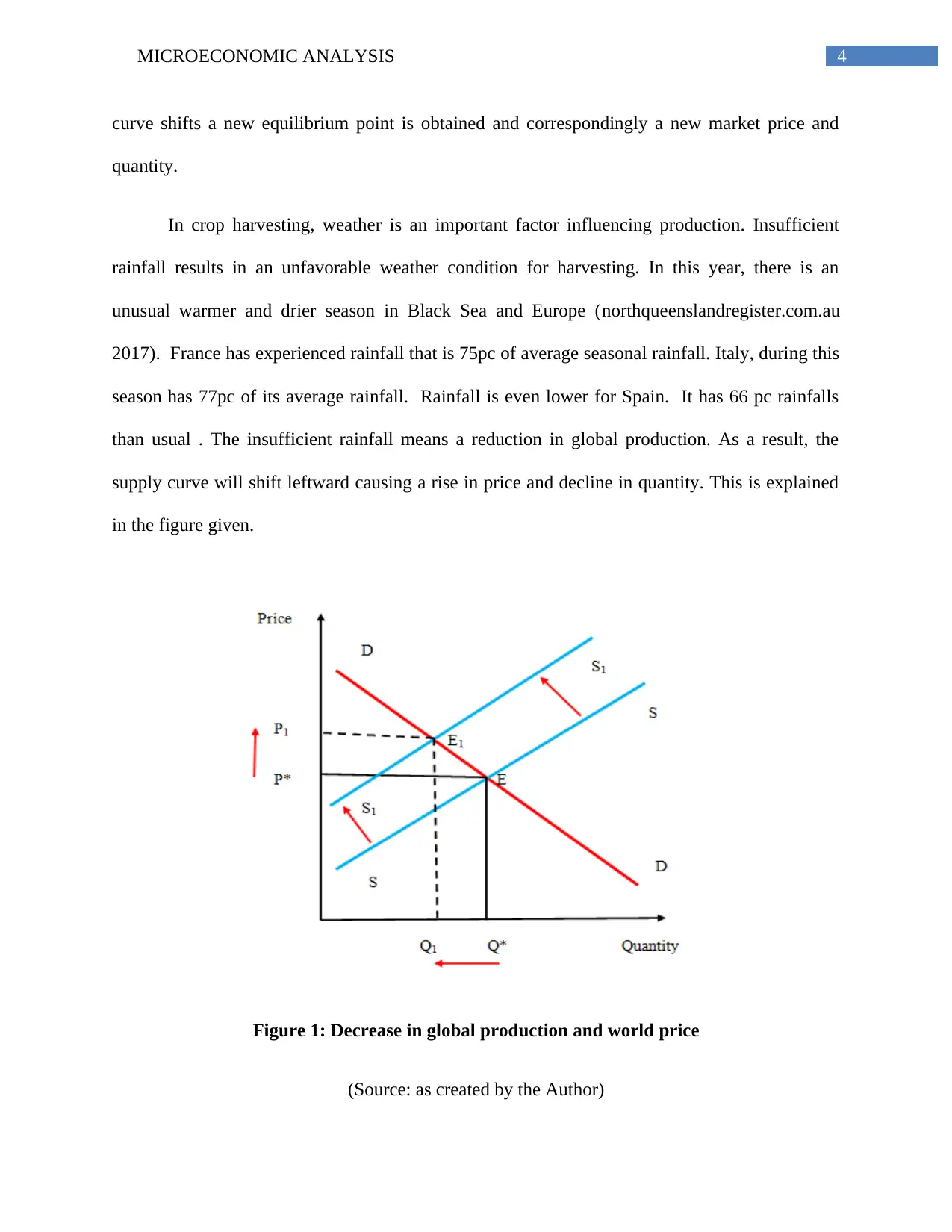
4MICROECONOMIC ANALYSIS
curve shifts a new equilibrium point is obtained and correspondingly a new market price and
quantity.
In crop harvesting, weather is an important factor influencing production. Insufficient
rainfall results in an unfavorable weather condition for harvesting. In this year, there is an
unusual warmer and drier season in Black Sea and Europe (northqueenslandregister.com.au
2017). France has experienced rainfall that is 75pc of average seasonal rainfall. Italy, during this
season has 77pc of its average rainfall. Rainfall is even lower for Spain. It has 66 pc rainfalls
than usual . The insufficient rainfall means a reduction in global production. As a result, the
supply curve will shift leftward causing a rise in price and decline in quantity. This is explained
in the figure given.
Figure 1: Decrease in global production and world price
(Source: as created by the Author)
curve shifts a new equilibrium point is obtained and correspondingly a new market price and
quantity.
In crop harvesting, weather is an important factor influencing production. Insufficient
rainfall results in an unfavorable weather condition for harvesting. In this year, there is an
unusual warmer and drier season in Black Sea and Europe (northqueenslandregister.com.au
2017). France has experienced rainfall that is 75pc of average seasonal rainfall. Italy, during this
season has 77pc of its average rainfall. Rainfall is even lower for Spain. It has 66 pc rainfalls
than usual . The insufficient rainfall means a reduction in global production. As a result, the
supply curve will shift leftward causing a rise in price and decline in quantity. This is explained
in the figure given.
Figure 1: Decrease in global production and world price
(Source: as created by the Author)
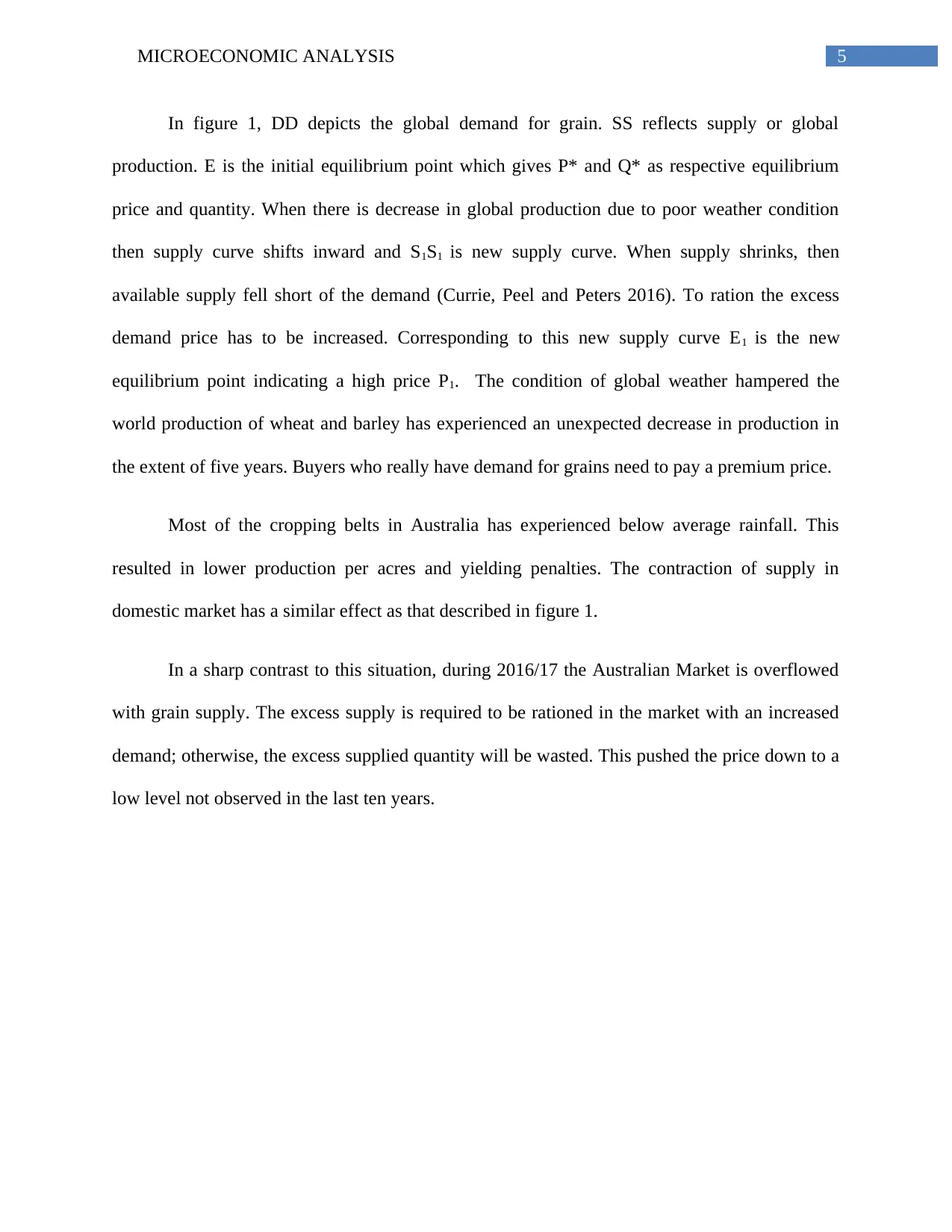
5MICROECONOMIC ANALYSIS
In figure 1, DD depicts the global demand for grain. SS reflects supply or global
production. E is the initial equilibrium point which gives P* and Q* as respective equilibrium
price and quantity. When there is decrease in global production due to poor weather condition
then supply curve shifts inward and S1S1 is new supply curve. When supply shrinks, then
available supply fell short of the demand (Currie, Peel and Peters 2016). To ration the excess
demand price has to be increased. Corresponding to this new supply curve E1 is the new
equilibrium point indicating a high price P1. The condition of global weather hampered the
world production of wheat and barley has experienced an unexpected decrease in production in
the extent of five years. Buyers who really have demand for grains need to pay a premium price.
Most of the cropping belts in Australia has experienced below average rainfall. This
resulted in lower production per acres and yielding penalties. The contraction of supply in
domestic market has a similar effect as that described in figure 1.
In a sharp contrast to this situation, during 2016/17 the Australian Market is overflowed
with grain supply. The excess supply is required to be rationed in the market with an increased
demand; otherwise, the excess supplied quantity will be wasted. This pushed the price down to a
low level not observed in the last ten years.
In figure 1, DD depicts the global demand for grain. SS reflects supply or global
production. E is the initial equilibrium point which gives P* and Q* as respective equilibrium
price and quantity. When there is decrease in global production due to poor weather condition
then supply curve shifts inward and S1S1 is new supply curve. When supply shrinks, then
available supply fell short of the demand (Currie, Peel and Peters 2016). To ration the excess
demand price has to be increased. Corresponding to this new supply curve E1 is the new
equilibrium point indicating a high price P1. The condition of global weather hampered the
world production of wheat and barley has experienced an unexpected decrease in production in
the extent of five years. Buyers who really have demand for grains need to pay a premium price.
Most of the cropping belts in Australia has experienced below average rainfall. This
resulted in lower production per acres and yielding penalties. The contraction of supply in
domestic market has a similar effect as that described in figure 1.
In a sharp contrast to this situation, during 2016/17 the Australian Market is overflowed
with grain supply. The excess supply is required to be rationed in the market with an increased
demand; otherwise, the excess supplied quantity will be wasted. This pushed the price down to a
low level not observed in the last ten years.
⊘ This is a preview!⊘
Do you want full access?
Subscribe today to unlock all pages.

Trusted by 1+ million students worldwide
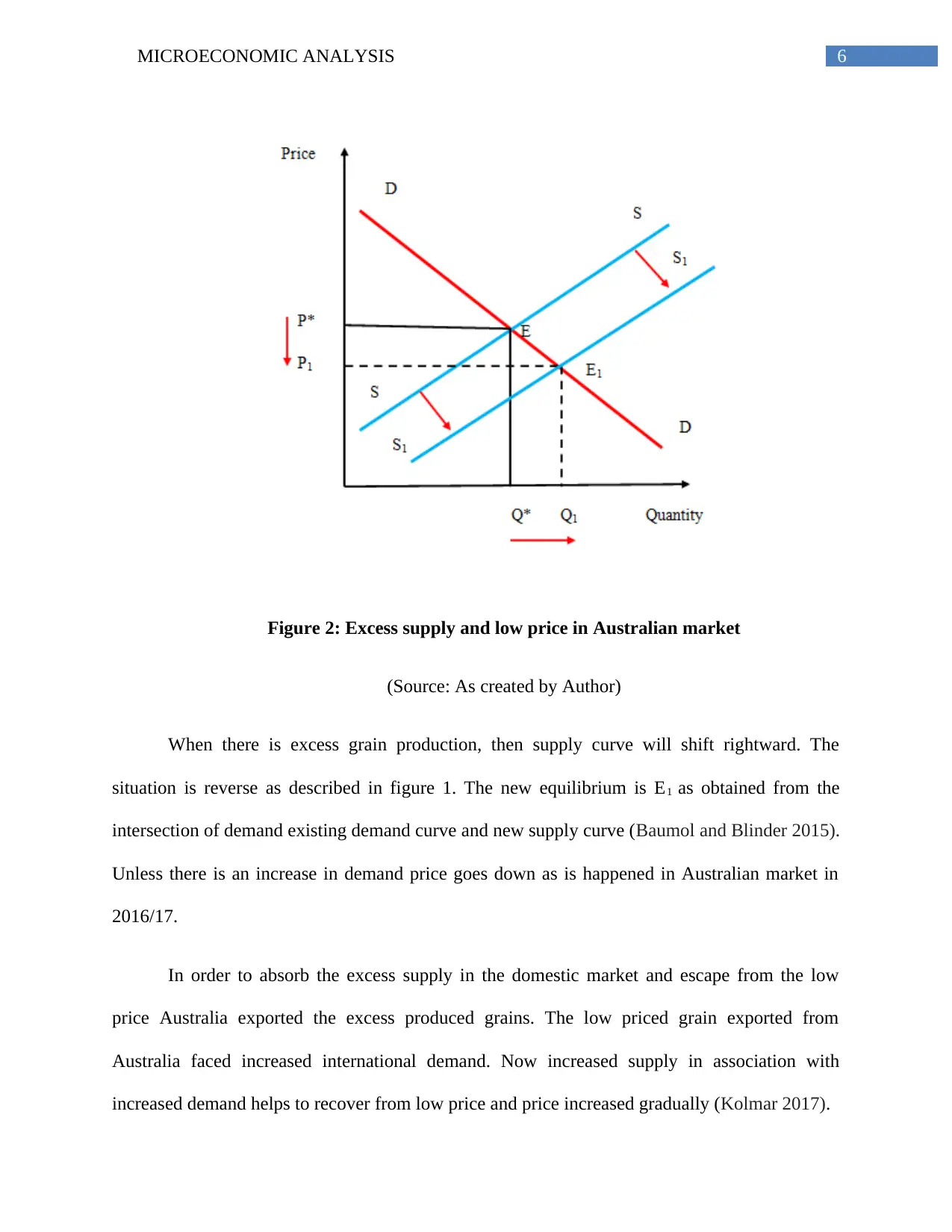
6MICROECONOMIC ANALYSIS
Figure 2: Excess supply and low price in Australian market
(Source: As created by Author)
When there is excess grain production, then supply curve will shift rightward. The
situation is reverse as described in figure 1. The new equilibrium is E1 as obtained from the
intersection of demand existing demand curve and new supply curve (Baumol and Blinder 2015).
Unless there is an increase in demand price goes down as is happened in Australian market in
2016/17.
In order to absorb the excess supply in the domestic market and escape from the low
price Australia exported the excess produced grains. The low priced grain exported from
Australia faced increased international demand. Now increased supply in association with
increased demand helps to recover from low price and price increased gradually (Kolmar 2017).
Figure 2: Excess supply and low price in Australian market
(Source: As created by Author)
When there is excess grain production, then supply curve will shift rightward. The
situation is reverse as described in figure 1. The new equilibrium is E1 as obtained from the
intersection of demand existing demand curve and new supply curve (Baumol and Blinder 2015).
Unless there is an increase in demand price goes down as is happened in Australian market in
2016/17.
In order to absorb the excess supply in the domestic market and escape from the low
price Australia exported the excess produced grains. The low priced grain exported from
Australia faced increased international demand. Now increased supply in association with
increased demand helps to recover from low price and price increased gradually (Kolmar 2017).
Paraphrase This Document
Need a fresh take? Get an instant paraphrase of this document with our AI Paraphraser
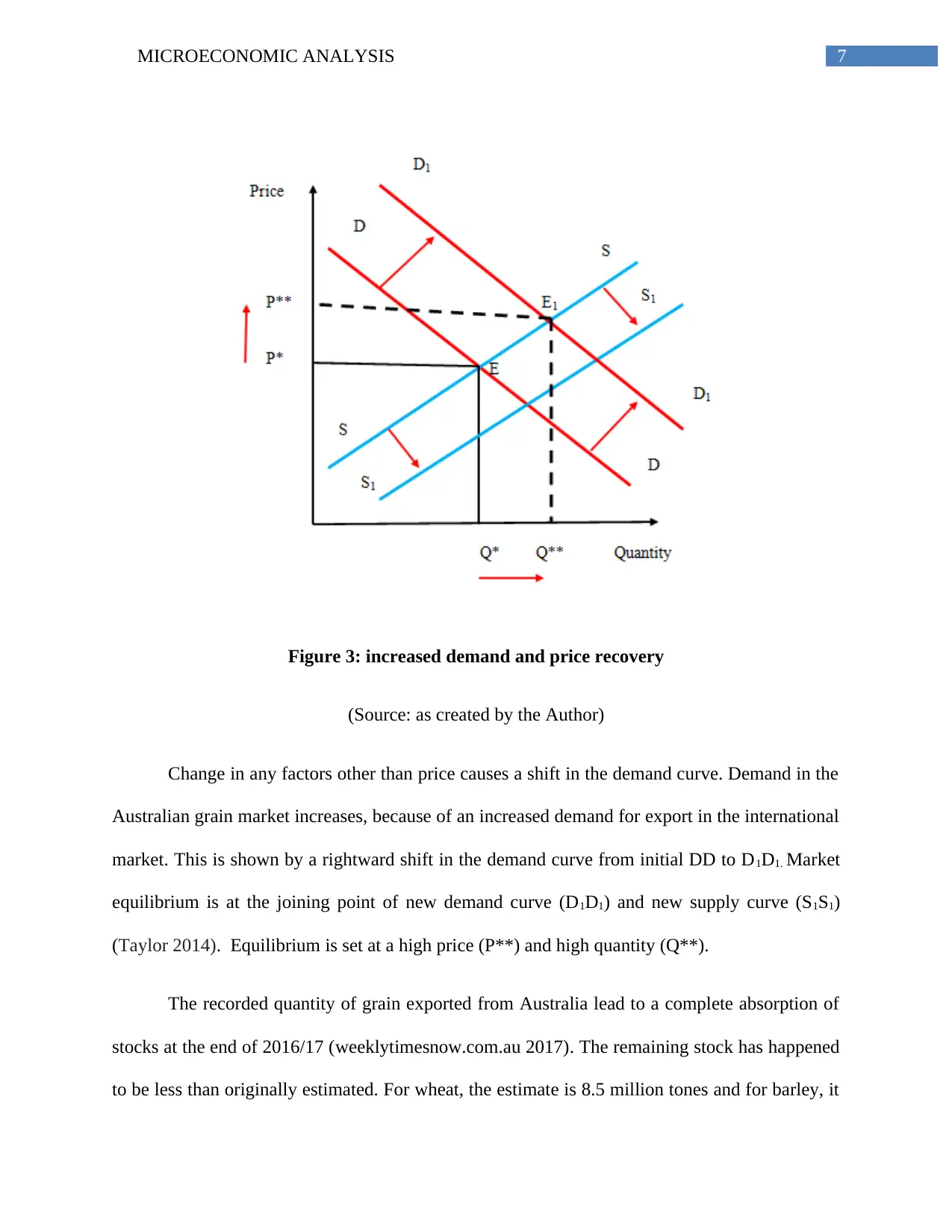
7MICROECONOMIC ANALYSIS
Figure 3: increased demand and price recovery
(Source: as created by the Author)
Change in any factors other than price causes a shift in the demand curve. Demand in the
Australian grain market increases, because of an increased demand for export in the international
market. This is shown by a rightward shift in the demand curve from initial DD to D1D1. Market
equilibrium is at the joining point of new demand curve (D1D1) and new supply curve (S1S1)
(Taylor 2014). Equilibrium is set at a high price (P**) and high quantity (Q**).
The recorded quantity of grain exported from Australia lead to a complete absorption of
stocks at the end of 2016/17 (weeklytimesnow.com.au 2017). The remaining stock has happened
to be less than originally estimated. For wheat, the estimate is 8.5 million tones and for barley, it
Figure 3: increased demand and price recovery
(Source: as created by the Author)
Change in any factors other than price causes a shift in the demand curve. Demand in the
Australian grain market increases, because of an increased demand for export in the international
market. This is shown by a rightward shift in the demand curve from initial DD to D1D1. Market
equilibrium is at the joining point of new demand curve (D1D1) and new supply curve (S1S1)
(Taylor 2014). Equilibrium is set at a high price (P**) and high quantity (Q**).
The recorded quantity of grain exported from Australia lead to a complete absorption of
stocks at the end of 2016/17 (weeklytimesnow.com.au 2017). The remaining stock has happened
to be less than originally estimated. For wheat, the estimate is 8.5 million tones and for barley, it
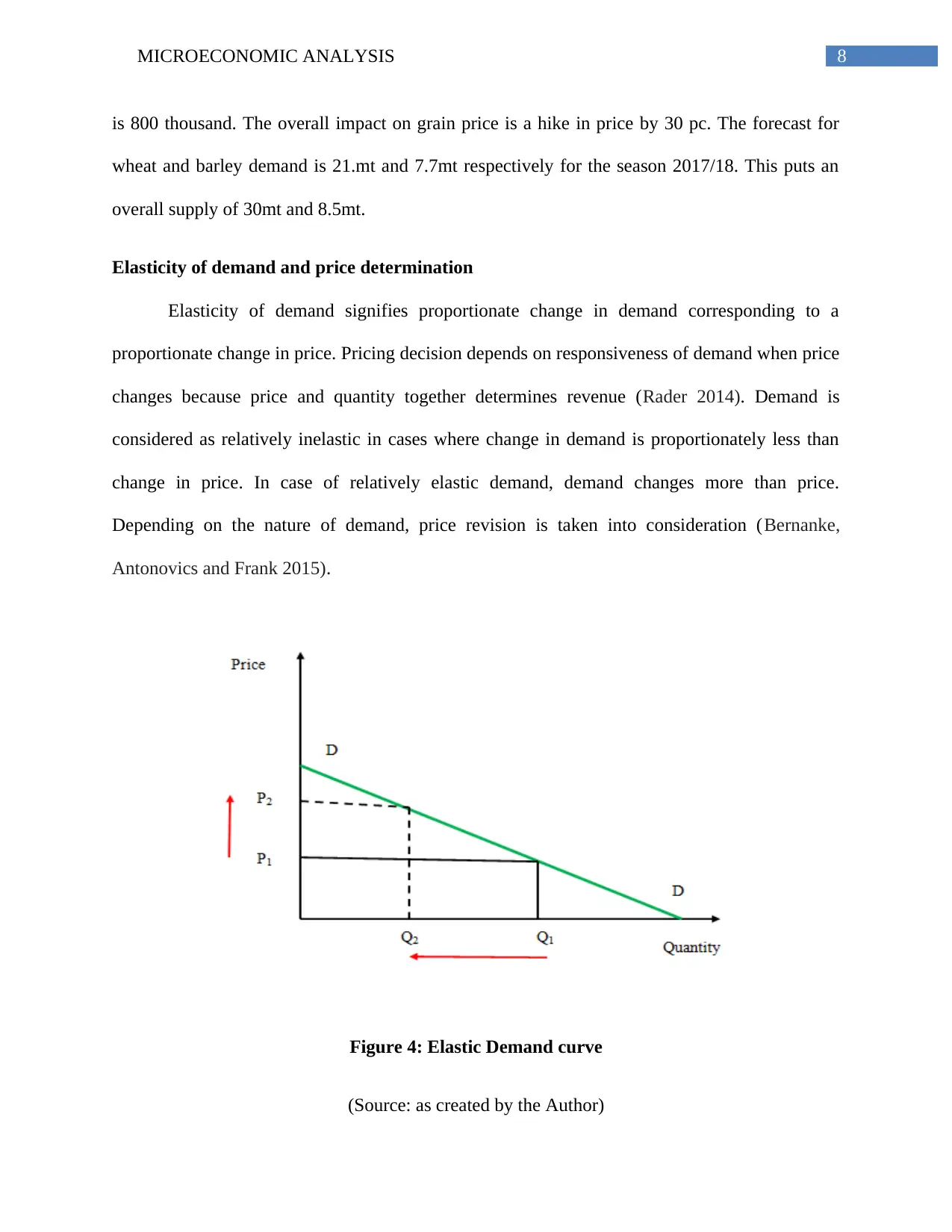
8MICROECONOMIC ANALYSIS
is 800 thousand. The overall impact on grain price is a hike in price by 30 pc. The forecast for
wheat and barley demand is 21.mt and 7.7mt respectively for the season 2017/18. This puts an
overall supply of 30mt and 8.5mt.
Elasticity of demand and price determination
Elasticity of demand signifies proportionate change in demand corresponding to a
proportionate change in price. Pricing decision depends on responsiveness of demand when price
changes because price and quantity together determines revenue (Rader 2014). Demand is
considered as relatively inelastic in cases where change in demand is proportionately less than
change in price. In case of relatively elastic demand, demand changes more than price.
Depending on the nature of demand, price revision is taken into consideration (Bernanke,
Antonovics and Frank 2015).
Figure 4: Elastic Demand curve
(Source: as created by the Author)
is 800 thousand. The overall impact on grain price is a hike in price by 30 pc. The forecast for
wheat and barley demand is 21.mt and 7.7mt respectively for the season 2017/18. This puts an
overall supply of 30mt and 8.5mt.
Elasticity of demand and price determination
Elasticity of demand signifies proportionate change in demand corresponding to a
proportionate change in price. Pricing decision depends on responsiveness of demand when price
changes because price and quantity together determines revenue (Rader 2014). Demand is
considered as relatively inelastic in cases where change in demand is proportionately less than
change in price. In case of relatively elastic demand, demand changes more than price.
Depending on the nature of demand, price revision is taken into consideration (Bernanke,
Antonovics and Frank 2015).
Figure 4: Elastic Demand curve
(Source: as created by the Author)
⊘ This is a preview!⊘
Do you want full access?
Subscribe today to unlock all pages.

Trusted by 1+ million students worldwide
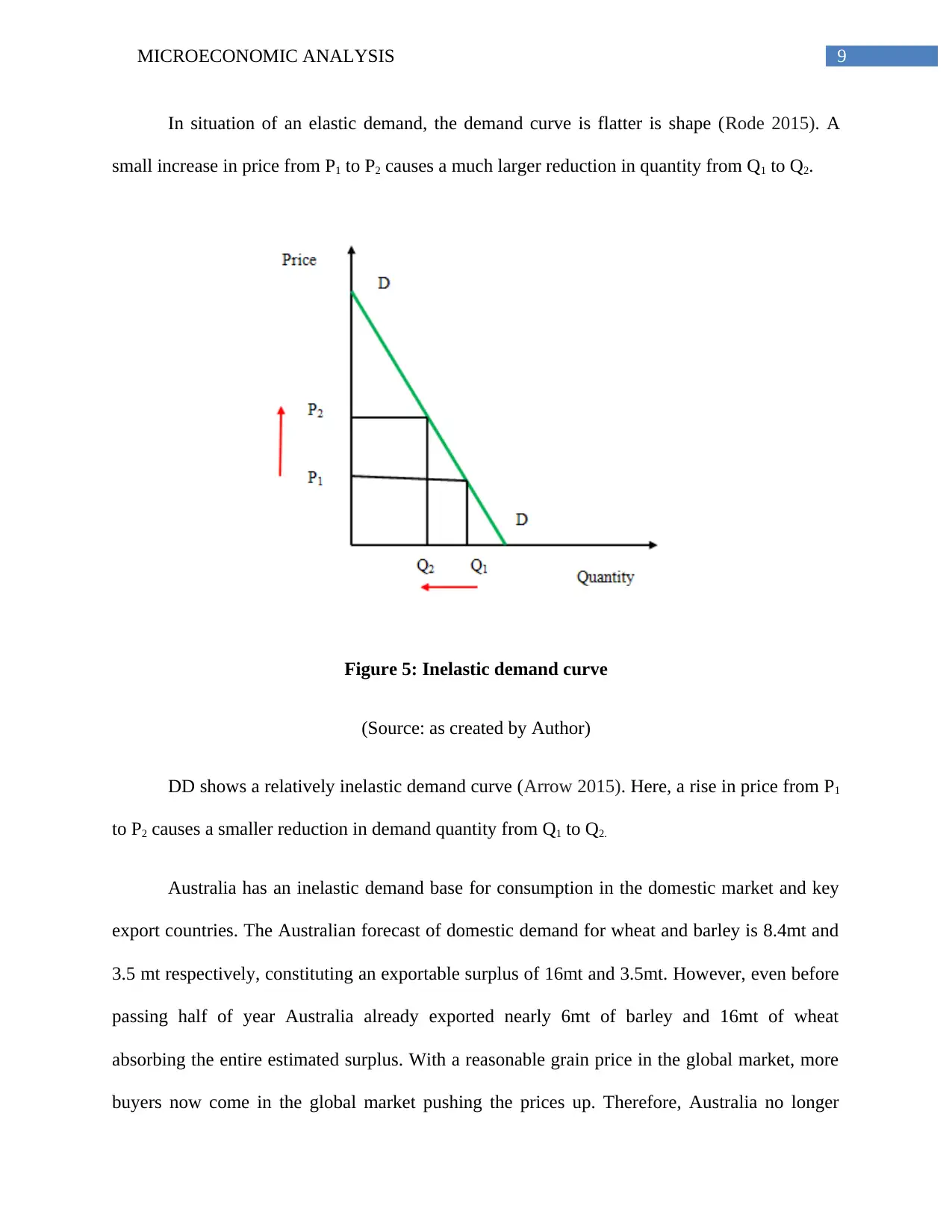
9MICROECONOMIC ANALYSIS
In situation of an elastic demand, the demand curve is flatter is shape (Rode 2015). A
small increase in price from P1 to P2 causes a much larger reduction in quantity from Q1 to Q2.
Figure 5: Inelastic demand curve
(Source: as created by Author)
DD shows a relatively inelastic demand curve (Arrow 2015). Here, a rise in price from P1
to P2 causes a smaller reduction in demand quantity from Q1 to Q2.
Australia has an inelastic demand base for consumption in the domestic market and key
export countries. The Australian forecast of domestic demand for wheat and barley is 8.4mt and
3.5 mt respectively, constituting an exportable surplus of 16mt and 3.5mt. However, even before
passing half of year Australia already exported nearly 6mt of barley and 16mt of wheat
absorbing the entire estimated surplus. With a reasonable grain price in the global market, more
buyers now come in the global market pushing the prices up. Therefore, Australia no longer
In situation of an elastic demand, the demand curve is flatter is shape (Rode 2015). A
small increase in price from P1 to P2 causes a much larger reduction in quantity from Q1 to Q2.
Figure 5: Inelastic demand curve
(Source: as created by Author)
DD shows a relatively inelastic demand curve (Arrow 2015). Here, a rise in price from P1
to P2 causes a smaller reduction in demand quantity from Q1 to Q2.
Australia has an inelastic demand base for consumption in the domestic market and key
export countries. The Australian forecast of domestic demand for wheat and barley is 8.4mt and
3.5 mt respectively, constituting an exportable surplus of 16mt and 3.5mt. However, even before
passing half of year Australia already exported nearly 6mt of barley and 16mt of wheat
absorbing the entire estimated surplus. With a reasonable grain price in the global market, more
buyers now come in the global market pushing the prices up. Therefore, Australia no longer
Paraphrase This Document
Need a fresh take? Get an instant paraphrase of this document with our AI Paraphraser
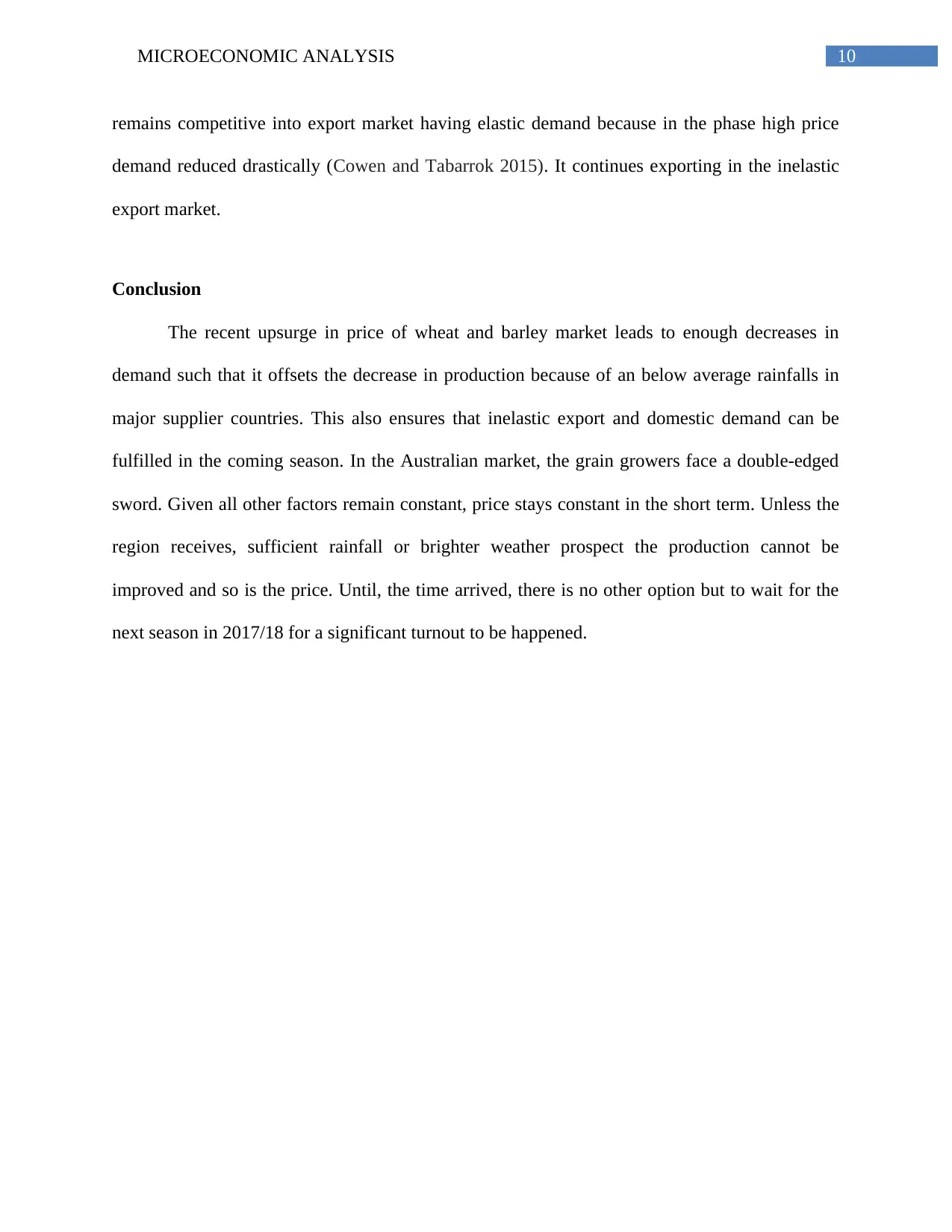
10MICROECONOMIC ANALYSIS
remains competitive into export market having elastic demand because in the phase high price
demand reduced drastically (Cowen and Tabarrok 2015). It continues exporting in the inelastic
export market.
Conclusion
The recent upsurge in price of wheat and barley market leads to enough decreases in
demand such that it offsets the decrease in production because of an below average rainfalls in
major supplier countries. This also ensures that inelastic export and domestic demand can be
fulfilled in the coming season. In the Australian market, the grain growers face a double-edged
sword. Given all other factors remain constant, price stays constant in the short term. Unless the
region receives, sufficient rainfall or brighter weather prospect the production cannot be
improved and so is the price. Until, the time arrived, there is no other option but to wait for the
next season in 2017/18 for a significant turnout to be happened.
remains competitive into export market having elastic demand because in the phase high price
demand reduced drastically (Cowen and Tabarrok 2015). It continues exporting in the inelastic
export market.
Conclusion
The recent upsurge in price of wheat and barley market leads to enough decreases in
demand such that it offsets the decrease in production because of an below average rainfalls in
major supplier countries. This also ensures that inelastic export and domestic demand can be
fulfilled in the coming season. In the Australian market, the grain growers face a double-edged
sword. Given all other factors remain constant, price stays constant in the short term. Unless the
region receives, sufficient rainfall or brighter weather prospect the production cannot be
improved and so is the price. Until, the time arrived, there is no other option but to wait for the
next season in 2017/18 for a significant turnout to be happened.
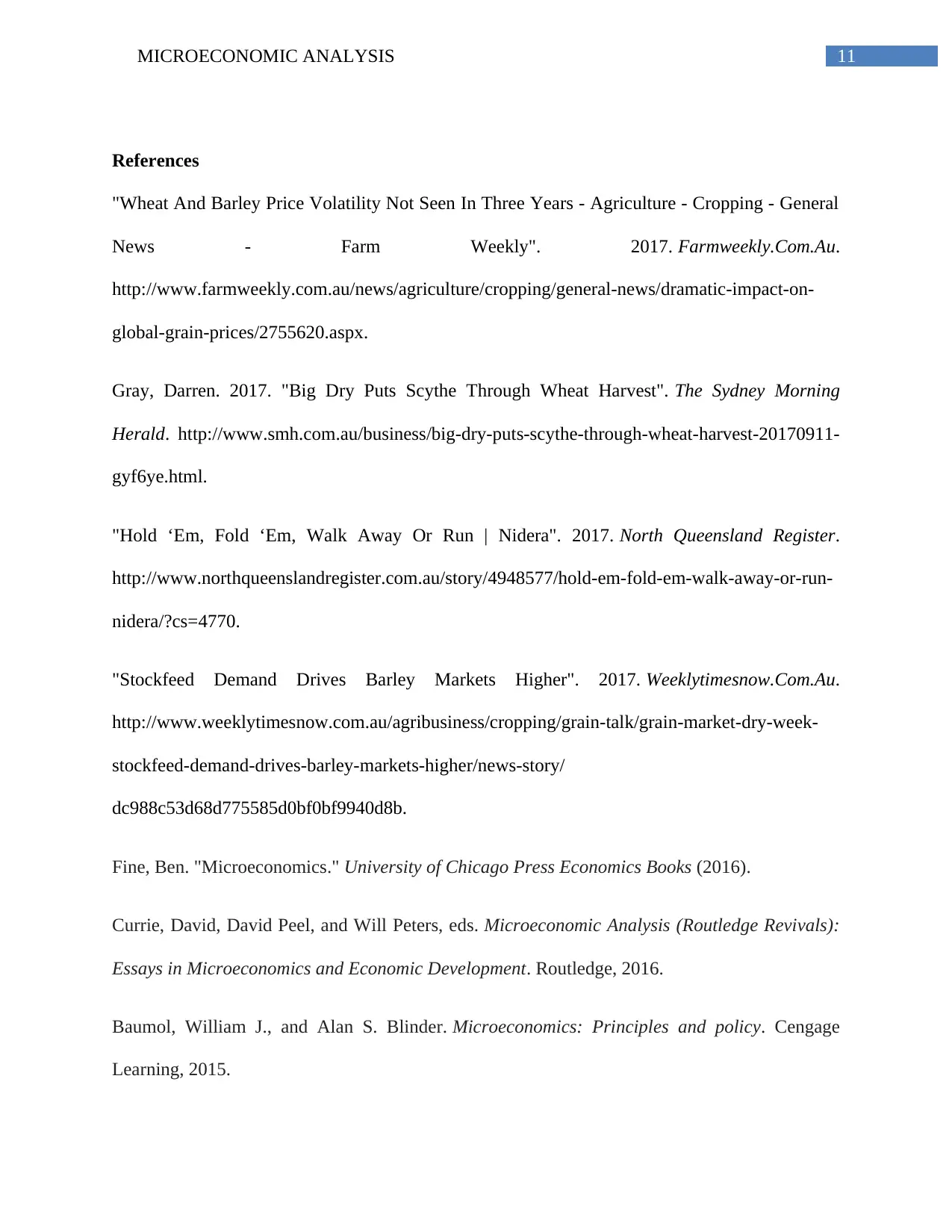
11MICROECONOMIC ANALYSIS
References
"Wheat And Barley Price Volatility Not Seen In Three Years - Agriculture - Cropping - General
News - Farm Weekly". 2017. Farmweekly.Com.Au.
http://www.farmweekly.com.au/news/agriculture/cropping/general-news/dramatic-impact-on-
global-grain-prices/2755620.aspx.
Gray, Darren. 2017. "Big Dry Puts Scythe Through Wheat Harvest". The Sydney Morning
Herald. http://www.smh.com.au/business/big-dry-puts-scythe-through-wheat-harvest-20170911-
gyf6ye.html.
"Hold ‘Em, Fold ‘Em, Walk Away Or Run | Nidera". 2017. North Queensland Register.
http://www.northqueenslandregister.com.au/story/4948577/hold-em-fold-em-walk-away-or-run-
nidera/?cs=4770.
"Stockfeed Demand Drives Barley Markets Higher". 2017. Weeklytimesnow.Com.Au.
http://www.weeklytimesnow.com.au/agribusiness/cropping/grain-talk/grain-market-dry-week-
stockfeed-demand-drives-barley-markets-higher/news-story/
dc988c53d68d775585d0bf0bf9940d8b.
Fine, Ben. "Microeconomics." University of Chicago Press Economics Books (2016).
Currie, David, David Peel, and Will Peters, eds. Microeconomic Analysis (Routledge Revivals):
Essays in Microeconomics and Economic Development. Routledge, 2016.
Baumol, William J., and Alan S. Blinder. Microeconomics: Principles and policy. Cengage
Learning, 2015.
References
"Wheat And Barley Price Volatility Not Seen In Three Years - Agriculture - Cropping - General
News - Farm Weekly". 2017. Farmweekly.Com.Au.
http://www.farmweekly.com.au/news/agriculture/cropping/general-news/dramatic-impact-on-
global-grain-prices/2755620.aspx.
Gray, Darren. 2017. "Big Dry Puts Scythe Through Wheat Harvest". The Sydney Morning
Herald. http://www.smh.com.au/business/big-dry-puts-scythe-through-wheat-harvest-20170911-
gyf6ye.html.
"Hold ‘Em, Fold ‘Em, Walk Away Or Run | Nidera". 2017. North Queensland Register.
http://www.northqueenslandregister.com.au/story/4948577/hold-em-fold-em-walk-away-or-run-
nidera/?cs=4770.
"Stockfeed Demand Drives Barley Markets Higher". 2017. Weeklytimesnow.Com.Au.
http://www.weeklytimesnow.com.au/agribusiness/cropping/grain-talk/grain-market-dry-week-
stockfeed-demand-drives-barley-markets-higher/news-story/
dc988c53d68d775585d0bf0bf9940d8b.
Fine, Ben. "Microeconomics." University of Chicago Press Economics Books (2016).
Currie, David, David Peel, and Will Peters, eds. Microeconomic Analysis (Routledge Revivals):
Essays in Microeconomics and Economic Development. Routledge, 2016.
Baumol, William J., and Alan S. Blinder. Microeconomics: Principles and policy. Cengage
Learning, 2015.
⊘ This is a preview!⊘
Do you want full access?
Subscribe today to unlock all pages.

Trusted by 1+ million students worldwide
1 out of 17
Related Documents
Your All-in-One AI-Powered Toolkit for Academic Success.
+13062052269
info@desklib.com
Available 24*7 on WhatsApp / Email
![[object Object]](/_next/static/media/star-bottom.7253800d.svg)
Unlock your academic potential
Copyright © 2020–2025 A2Z Services. All Rights Reserved. Developed and managed by ZUCOL.





